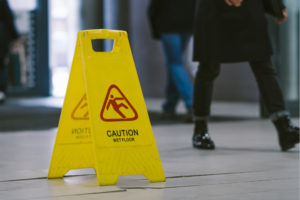Common Insurance Company Defenses in Slip and Fall Cases
 Serious fall injuries, such as spine injuries, can translate to over $4 million in medical expenses. Compensation is available for these medical expenses. This compensation also usually includes money for other economic losses, such as lost wages and all noneconomic losses, such as pain and suffering.
Serious fall injuries, such as spine injuries, can translate to over $4 million in medical expenses. Compensation is available for these medical expenses. This compensation also usually includes money for other economic losses, such as lost wages and all noneconomic losses, such as pain and suffering.
A Rockford personal injury attorney works diligently to collect evidence and build a case for compensation. But these efforts are not enough. The best Rockford personal injury attorneys are also prepared to counter some common insurance company defenses, as outlined below.
Assumption of the Risk
Warning signs, like Wet Floor or Construction Zone, make the assumption of the risk defense easier to prove in court. This doctrine excuses landowner liability if the victimvoluntarily assumed a known risk.
Most people voluntarily assume the risk of walking down the hall or climbing stairs. So, the first element is usually straightforward.
The second element is harder to prove. Insurance company lawyers must prove the victim saw the sign, could read the sign and could understand what it meant. If the sign features graphics approved by the American National Standards Institute, like a stick figure falling, these things are easier to prove.
Open and Obvious
Illinois law does not permit recovery if the victim fell because of an open and obvious hazard, such as a pallet in a grocery store aisle or a sinkhole in a walkway. However, the meaning of “open and obvious” is subjective.
For example, many older people suffer from Age-related Macular Degeneration (AMD), which obscures straight-ahead vision. Many times, the symptoms are so mild people do not realize there is a problem unless they are in a dimly-lit room or conditions are otherwise adverse. As a result, what is “open and obvious” to one victim may be almost invisible to someone else.
On a related note, many older people have gait disorders. When they lose their balance, they usually fall. These conditions sometimes come up in comparative negligence situations, as outlined below.
Lack of Evidence
As mentioned, the victim/plaintiff has the burden of proof in a negligence case. This burden includes proving the victim’s injuries were not accidental but rather the result of negligence. Without an independent witness or video evidence, such a showing can be difficult to make.
Fortunately, Illinois has a limited res ipsa loquitur (the thing speaks for itself) rule. This doctrine applies if:
- The injury is normally associated with negligence, and
- The defendant substantially controlled the place where the injury occurred.
If the res ipsa rule applies, negligence is presumed as a matter of law. There is no need to independently prove cause.
Comparative Negligence
The above defenses forgive liability. Assumption of the risk and the open and obvious doctrine are absolute defenses. Comparative negligence, however, is usually a partial defense. The court would reduce the amount of damages the victim/plaintiff receives if the victim contributed to the fall. Some examples include:
- Failure to use a cane or other medical device,
- Walking too quickly,
- Careless behavior, like sliding down a handrail, and
- Distracted walking.
Illinois is a modified comparative fault state with a 51 percent threshold. So, even if the victim was 49 percent responsible for the fall, the landowner is liable for a proportionate share of damages.
Count on Experienced Attorneys
Fall injury victims are usually entitled to substantial compensation. For a free consultation with an experienced personal injury lawyer in Rockford, contact Fisk & Monteleone, Ltd. We routinely handle matters in Winnebago County and nearby jurisdictions.
